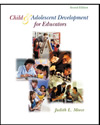| aggression | Behavior that is intentionally aimed at harming or injuring another person; see instrumental aggression, hostile aggression.
|
 |
 |
 |
| bullying behavior | The most common form of aggression often taking the form of embarrassing people, hitting, destroying property, and ridiculing.
|
 |
 |
 |
| clique | A small peer group, generally same-sex and same race, that has a clear social structure with one or two members serving as leaders.
|
 |
 |
 |
| conflict resolution program | School-based intervention programs designed to help students acquire the skills they need to resolve conflict; components include defining the problem, brainstorming about possible solutions, and choosing solutions that benefit both sides (called win-win solutions).
|
 |
 |
 |
| conventional level | According to Kohlberg, the second level of moral judgment, characterized by individuals who accept society's rules for right and wrong and obey authority figures; contrast with preconventional level and postconventional level.
|
 |
 |
 |
| crowds | The largest adolescent group that is made up of individuals with similar reputations and stereotyped identities that is not conducive to close interpersonal relations.
|
 |
 |
 |
| ethic of care | Gilligan's argument that women are socialized to take responsibility for the well-being of others and therefore emphasize connections between people as well as of justice.
|
 |
 |
 |
| homophobia | An irrational fear and hatred of homosexuals.
|
 |
 |
 |
| homosexual orientation | Consistent sexual attraction toward persons of the same gender that includes fantasies, conscious attraction, romantic feelings, or sexual behaviors.
|
 |
 |
 |
| hostile aggression | In 3- and 4-year-old children, behavior that is intended to hurt or harm another person; see aggression. Contrast with instrumental aggression.
|
 |
 |
 |
| inductive discipline | A discipline technique in which parents offer explanation for their rules and ask children to reflect on their behavior; helps children develop self-control and self-discipline.
|
 |
 |
 |
| instrumental aggression | In young children, behavior that is intended to obtain an object, to protect a play space, or to get one's way; behavior that is not intended to hurt or harm another person; see aggression. Contrast with hostile aggression.
|
 |
 |
 |
| neglected peers | Children who are seldom chosen as work or play partners by their peers.
|
 |
 |
 |
| peer | A person equal in age, rank, or maturity to another person.
|
 |
 |
 |
| peer popularity | One whose presence or opinion is sought after by others of the same age; the key determinants are the abilities to initiate and to maintain positive interactions with others.
|
 |
 |
 |
| peer rejection | Ignoring or avoiding those who are strongly disliked by their peers; those rejected are often inattentive, aversive, threatening, hostile, and disruptive.
|
 |
 |
 |
| perspective taking skills | One of the important aspects of the development of social cognition that involves being able to imagine what others may be thinking and feeling.
|
 |
 |
 |
| postconventional level | According to Kohlberg, the third level of moral judgment, characterized by individuals who develop their own set of principles to define what is morally right and wrong; contrast with preconventional level and conventional level.
|
 |
 |
 |
| preconventional level | According to Kohlberg, the first level of moral judgment, characterized by individuals who approach moral issues from a hedonistic or pleasure-oriented perspective; contrast with conventional level and postconventional level.
|
 |
 |
 |
| prejudice | Unfounded negative feelings towards a person because of their membership in a group.
|
 |
 |
 |
| prosocial behavior | Actions stemming from an appreciation that others' needs are as important or more important than one's own; supportive actions, such as sharing, helping, and care giving.
|



 2002 McGraw-Hill Higher Education
2002 McGraw-Hill Higher Education